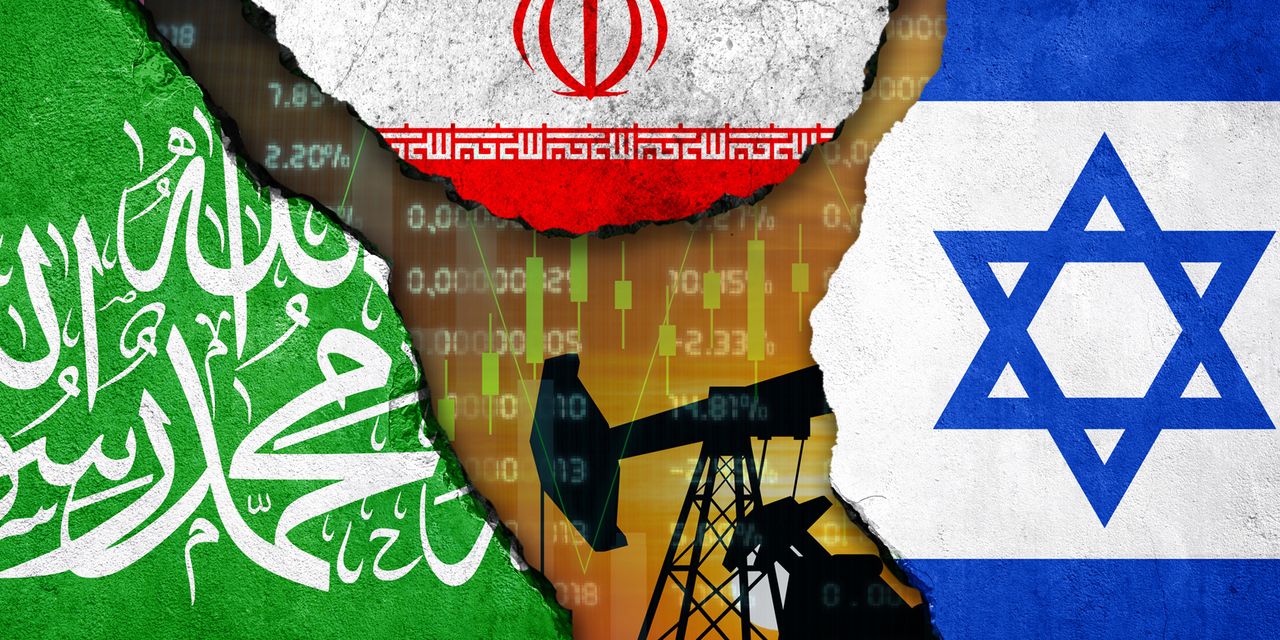The Hamas attack on Israel shocked the world, but didn’t trigger the big rally that some traders may have expected in a market that saw oil prices at their highest levels of the year less than two weeks ago.
“Oil in the $100s is not out of the realms of possibilities,” said Manish Raj, managing director at Velandera Energy Partners. So far, however, the “crisis seems to have been contained within Israeli borders.”
Meanwhile, investors in other markets will remain fixated on how oil performs amid the conflict, analysts said.
“The human tragedy and geopolitical implications aside, from a market standpoint the attack matters because rising geopolitical tensions mean higher oil prices and the higher oil goes, the stronger the additional headwind on stocks and bonds,” said analysts at Sevens Report Research, in a note.
On Monday, the front-month November contract for U.S. crude benchmark West Texas Intermediate oil
CL.1,
CLX23,
climbed $3.59, or 4.3%, to settle at $86.38 a barrel on the New York Mercantile Exchange, for the highest finish since Oct. 3, FactSet data show. Prices had settled at a more than one-year high of $93.68 on Sept. 27.
Global benchmark Brent crude saw its December contract
BRNZ23,
BRN00,
settled at $88.15 a barrel on ICE Futures Europe, up $3.57, or 4.2%, on Monday. It’s down from the Sept. 27 settlement of $96.55, which was the highest since November.
“It seems oil’s political risk premium has become tame,” said Raj, who expressed surprise that oil prices haven’t jumped even more. “Traders are not convinced that the crisis will spread and affect” the senior producers of the Organization of the Petroleum Exporting Countries.
The trigger for a substantial price hike would be if “Israel decides to open direct confrontation with Iran,” he said.
Analysts have also raised worries that the conflict will impact U.S. relations with Saudi Arabia, which had been showing recent signs of softening.
Read: ‘Fear trade’: What Israel-Hamas war means for oil prices and financial markets
What happened?
Over the weekend, Hamas, the Palestinian militant group that controls the Gaza Strip, launched an attack from Gaza on Israel, leading the Israeli military to launch a wave of attacks on Gaza. More than 700 Israelis have been confirmed dead and least 560 Palestinians have been killed, according to a report from The Wall Street Journal.
Separately, the Wall Street Journal reported that Iran helped to plot the attack on Israel. The Times of Israel, however, reported Monday that Nasser Kanani, Iran’s foreign ministry spokesman, told reporters that accusations linked to an Iranian role in the conflict are based on “political reasons” and that the Islamic Republic does not intervene “in the decision-making of other countries, including Palestine.”
The “ultimate wild move” for the oil market would come if Israel attacks Iran and Iran retaliates with action impeding oil flows in the Strait of Hormuz, said Tom Kloza, global head of energy analysis at the Oil Price Information Service, a Dow Jones company.
With 20 million barrels a day of petroleum moving through that narrow channel between the Persian Gulf and the Gulf of Oman, the Strait of Hormuz would reassert itself as the “world’s most treacherous economic chokepoint,” said Kloza.
Commodities Corner (November 2018): Here’s what U.S. waivers on Iran oil sanctions mean for the global crude market
50th anniversary of Yom Kippur
The surprise Hamas attack on Israel brings back memories of the Yom Kippur War between Egypt, Syria and Israel, which happened 50 years ago in October 1973.
After the U.S. provided emergency aid to Israel for the conflict, the Organization of Arab Petroleum Exporting Countries implemented an oil embargo against the U.S., leading oil prices in the nation to nearly quadruple to $11.65 a barrel by January 1974, according to Federal Reserve History.
“Without question, oil prices will be affected by the current conflict” between Israel and Hamas, wrote Michael Lynch, in a Forbes article on Sunday. “Violence anywhere in the Middle East tends to raise tension in the oil market, even when it is far from any oil fields or indeed oil producing nations.”
Lynch, who’s also president of Strategic Energy & Economic Research, stressed in the article that “this is not your father’s (or mother’s) oil crisis. Yes, a surprise attack caught Israel off guard, yes this is the Fiftieth Anniversary of the October War, but little else is the same.”
The first oil crisis came after years of struggle between the oil companies that produced most of the oil in OPEC nations and their governments, with taxation, control and ownership contested, he said. In 1973, the oil market was already very tight after years of soaring demand, and the loss of oil supply combined with uncertainty about the duration of the war saw panic buying in oil, he said.
This time around, “the volatility and higher prices are unlikely to be lasting, depending mostly on the response of oil producers and other governments, especially the U.S.,” said Lynch.
Iran and Saudi Arabia
For now, the rise in oil prices has come “not because of supply disruption, but the potential for it,” said Edward Gardner, commodities economist at Capital Economics, in Monday note.
“If the U.S. were to judge that Iran is involved in Hamas’s attack, this could lead it to ‘turn the screws’ on Iran’s oil exports by enforcing sanctions more strictly,” he said.
Iranian crude production has topped 3 million barrels a day and oil exports are approaching 2 million barrels a day, the Wall Street Journal reported in late September, citing numbers from analysts. The U.S. had been backing away from some actions that were meant to stop Iran’s oil shipments, with negotiations between Washington and Tehran leading to the release of five American detainees who were imprisoned in Iran.
The spotlight will be on Iran’s daily export of 2 million barrels of oil, said Velandera Energy’s Raj. “If the U.S. no longer looks the other way while Iran averts sanctions, 2 million daily barrels are at risk.”
The Israel-Hamas conflict will also make it harder, if not impossible for Saudi Arabia and Israel to “normalize relations,” said Gardner. “Recently, it had been looking like a Saudi-Israel peace deal, brokered by the U.S., was on the cards” and as part of that, Saudi Arabia had indicated it would be willing to boost oil supply next year.
See: Biden’s hopes for normalized Israeli-Saudi relations could be casualty of new Mideast war
Rally for oil, but not for gasoline
So while oil prices have rallied on all of that, they haven’t rallied as much as some might expect.
“So many of these supply risks are still just that — risks,” said Gardner.
Capital Economics had been forecasting the global oil market to be in a 1.2 million barrel per day supply deficit in the second half of this year due to strong demand and supply cuts by OPEC and its allies, followed by a finely balanced market in 2024, said Gardner.
If these supply risks were to materialize, then we would have to consider raising our forecast for the Brent crude price, which is currently for $85 a barrel by year-end 2024, he said.
As for the psychologically important $100 a barrel mark for oil, the case for that “got stronger,” said OPIS’s Kloza, but that might only happen in December or the first quarter of 2024.
Of course, among the big questions for consumers is what does the risk of higher oil prices mean for gasoline at the pump. The answer may be surprising.
“U.S. gasoline prices remain tilted toward much lower numbers,” said Kloza. Retail prices have another 25 cents to 40 cents a gallon to fall in order to catch up with the 50 cents to $1.50 a gallon drops the fuel has seen at the wholesale level, he said.
Read: Demand destruction sinks oil prices as gasoline inventories send warning signal
“Gasoline prices will not be rising this month despite the horrors of what happened Saturday,” he said, but if there’s an Israeli retaliatory strike against Iran, “the calculus immediately changes.”
For now, “there is a contraseasonal dip in demand,” and travel demand tends to slip after incidents of terrorism, he said. “The trend for gas prices is clearly lower and we could see gasoline fetch a price only a few dollars above crude oil benchmarks in the current calendar quarter.”
Read the full article here











Leave a Reply